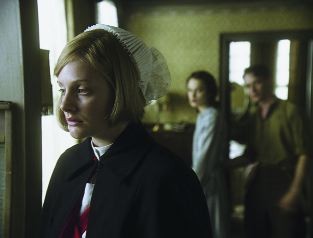Chaotic imagination

Great stories touch on many themes and give us a long list of things that they could be said to be “about.” As I tell my students, if you think Moby-Dick is just about whale- hunting, you weren’t paying attention. Atonement, based on the best-selling 1992 novel by British author Ian McEwan, is an ambitious tale that explores guilt, forgiveness, remorse, family jealousies, inequities of the class system, the power of imagination, the role of the artist and the sanctity of the creative process. It is also a love story, which is where many such sprawling epics begin and end.
The tale starts at a fancy country estate on a hot day in 1935. A lazy weekend of swimming, drinking and eating is planned, complete with visiting cousins and a new pal of the family’s only son. The key players in the drama of the day are 13-year-old Briony Tallis (Saoirse Ronan), a budding playwright who longs to be older and more sophisticated; her elder sister, Cecilia Tallis (Keira Knightley), who has just graduated from Cambridge and seems at loose ends; and Robbie Turner (James McAvoy), the family housekeeper’s son who also attended Cambridge, thanks to the generosity of the Tallis clan, and who hopes to study medicine.
What transpires at the Tallis estate on this oppressively hot and sticky day will affect not only the principals in the drama but every single supporting player for the remainder of their lives. Simmering passion starts to boil over as the day progresses, fueled by a D. H. Lawrence–like moment near the estate’s stately fountain. Cecilia and Robbie ignore their class differences to declare their true feelings. Briony, who has a crush on the handsome Robbie, happens to see what is going on. Employing a toxic combination of anger, fear, resentment and imagination, she kick-starts a series of events that quickly move from innocent to tragic as the supporting players take their turns in the spotlight.
The film, directed by Joe Wright (Pride and Prejudice, which also starred Knightley), with a script by Christopher Hampton (who scripted Dangerous Liaisons), is less concerned with coincidence than with fate. By highlighting the way that petty concerns and burgeoning artistic imagination can together create chaos, Atonement suggests how our actions can get away from us until we are left staring in horror at the results.
The story takes us to the battlefield of Dunkirk in 1940 (which director Wright portrays as a malignant purgatory with echoes of Dali and Fellini, complete with carousel), where Robbie comes face-to-face with the horrors that were just abstract concepts on that summer day in 1935. From there it moves from hospital to hospital, as the procession of the war dead and wounded roll in and out, nursed by Cecilia and Briony, who perform their selfless deeds for very different reasons. Cecilia wants to forget what might have been, while Briony must pay penance for her sins.
One of the most moving scenes in the film is where Briony (the young adult Briony is played by Romola Garai) holds the hand of a dying French soldier in the darkness of a hospital alcove, assuming the role of his faraway lover to provide him solace during his last minutes of life. The scene not only articulates Briony’s blossoming humanity, but suggests the ways that art and imagination can feed the human spirit instead of causing mischief and pain.
Atonement is a sad tale. But just when it appears that any semblance of hope will fade away like smoke on a battlefield, the film provides a curious coda set some 60 years later, which suggests another way that memories and imagination can be put to use.





